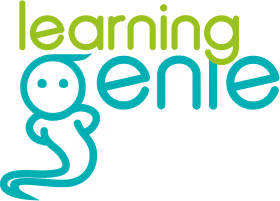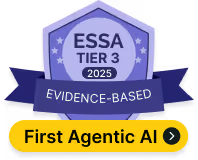Used by over 200+ school districts and 50,000+ educators to elevate classroom instruction.




































































































Tech & Learning Best of Show Award at ISTELive!
We’re proud to be recognized for helping shape the future of education. With our AI-powered platform, PreK–12 educators and students are co-creating inclusive, standards-aligned, and future-ready curriculum in ways that were never before possible. This award honors our commitment to empowering student voice, elevating educator impact, and reimagining the learning experience—one classroom at a time.
ESSA Evidence-Based
Learning Genie has implemented its program using a structured Logic Model and validated its effectiveness through a Quasi-Experimental Design study. This evaluation was independently conducted by Johns Hopkins University-Center for Research & Reform in Education.
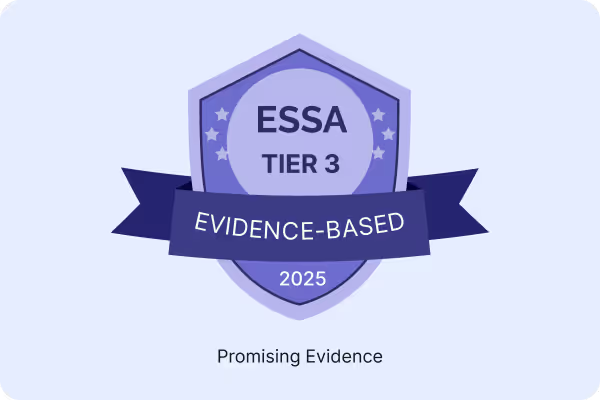
Certifications and Collaborative Research
Demonstrating commitment to high standards in inclusivity, digital learning excellence, data privacy, AI safety, and interoperability through trusted certifications.
Our platform fully complies with FERPA and state privacy laws, operating efficiently without collecting personally identifiable data. Designed specifically for schools and districts, we provide robust data protection tailored to your needs.
With trusted certifications and advanced technology, we ensure privacy and quality go hand in hand, giving you confidence in every step.








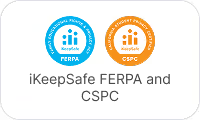
Key Highlights of Our Smart Teaching Tools
Transform your teaching with intuitive tools that help you create personalized, impactful curriculum and materials in seconds.
Standards Alignment
Alignment with 50 states' learning standards, interdisciplinary subject matter, and your own scope and sequence documents.
AI recommendations further enhance and support your instruction and implementation, ensuring effective teaching.
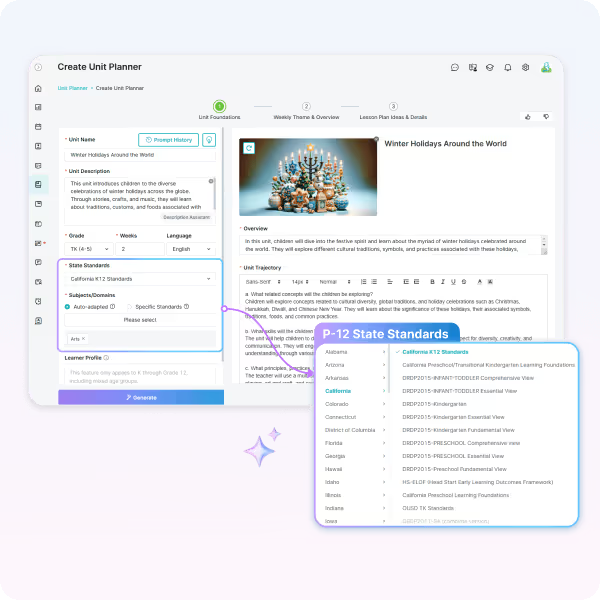
Tailor Unit Planning with Portrait of a Graduate
Translate PoG attributes into specific, measurable learning goals.
Embed them into weekly plans and unit outcomes.
Monitor growth in both academic and future-ready competencies
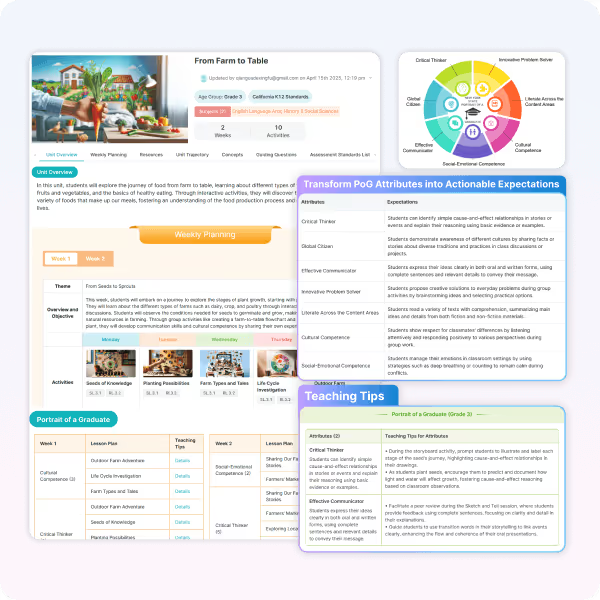
Localized Curriculum
Curriculum Genie localizes content to resonate with students’ lived experiences, helping teachers design units that connect learning to local cultures, communities, and identities—deepening engagement and meaning.
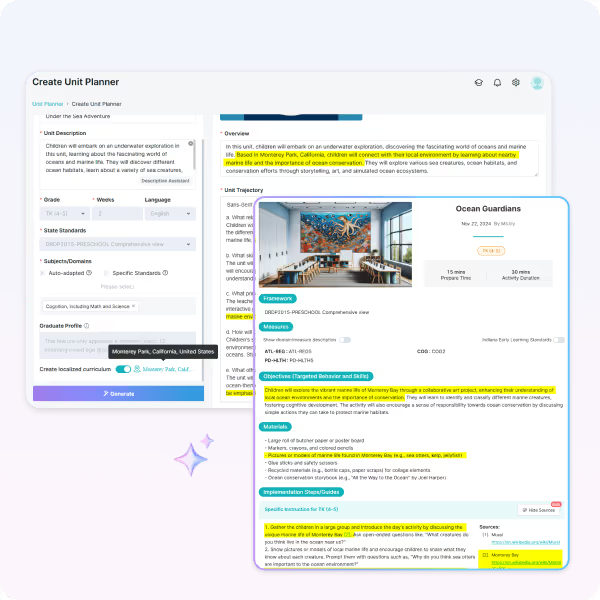
UDL for Inclusive Instructions
Personalizes curriculum and differentiates instruction to meet the unique needs of every student.
This approach leverages Universal Design for Learning to address the needs of learners with IEPs/IFSPs, English Language Learners, and incorporates Culturally and Linguistically Responsive Practices.

Assessment Integration
Strengthens the link between instruction and assessment using a diversified and balanced assessment system.
Uses assessment to drive better outcomes, ensuring continuous improvement in student learning.
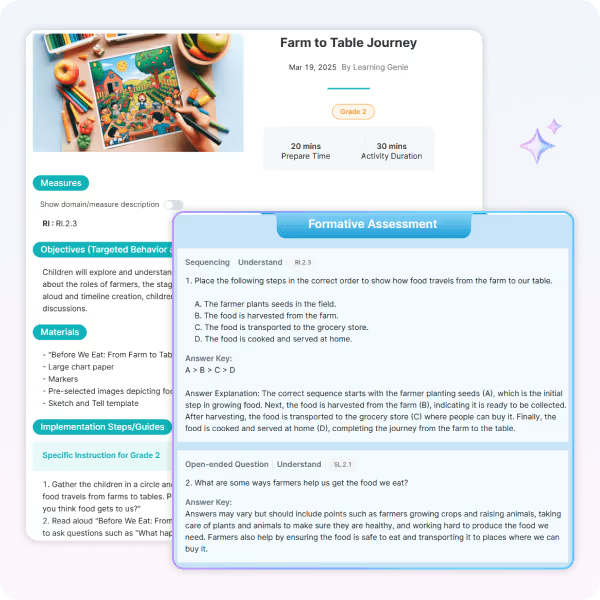
Student-Teacher Co-Creation
Engages children in the curriculum design process by offering them meaningful choices, allowing them to contribute to their own learning journey.
This approach not only enhances student engagement but also promotes a sense of ownership and encourages the development of self-regulation skills.
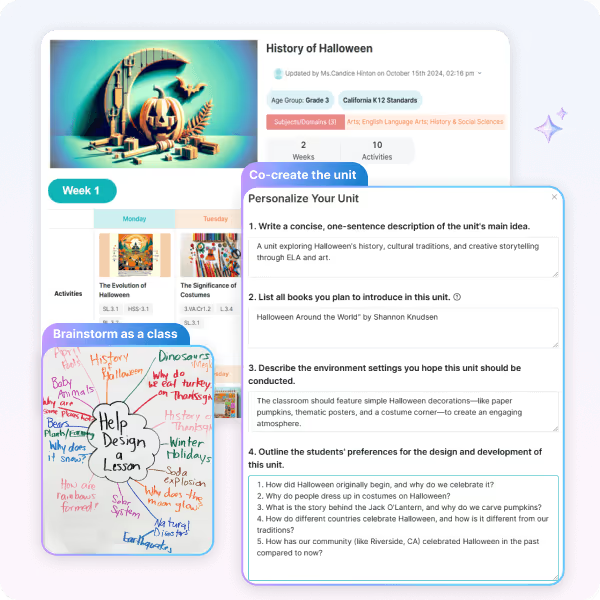
Instructional Strategy Meets Student Engagement
Curriculum Genie recommends evidence-based EduProtocol templates aligned to lesson intent, then generates ready-to-teach, high-engagement activities—centered around cognitive rigor and real learning outcomes.
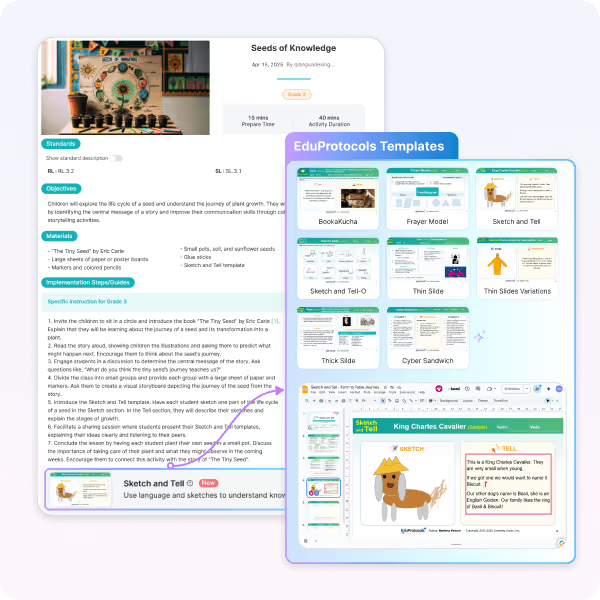







Transforming Education with AI
Curriculum Genie uses advanced AI (such as GPT-4, GPT-O1) to transform teaching. Our all-in-one platform saves time and enhances every aspect of your teaching journey.

High-Impact Content
Curriculum Genie doesn’t just generate content—it crafts lessons with instructional intent, supporting multiple pathways for learning.
Built with Universal Design for Learning and culturally responsive pedagogy, each plan meets students where they are, and takes them further.

Inclusive & Culturally Responsive Instruction
Tailors curriculum to meet the unique needs of IEP and ELD children, while embracing the unique cultures and languages of children from diverse cultural backgrounds.

Standard Alignment & Assessment Integration
Alignment with 40+ states’ learning standards, interdisciplinary subject matter, and your own scope and sequence documents, using AI recommendations to enhance and support the instruction and implementation.
All-in-One Solutions for Educators
AI Unit Planner
Standard Alignment & Assessment Integration: Aligns with state standards and uses AI to support interdisciplinary learning and connect instruction with assessments;
Localized Curriculum: Localizes curriculum to engage students in meaningful and relevant learning experiences;
Inclusive & Culturally Responsive Instruction: Tailors curriculum to meet students' unique needs while embracing their cultures and languages.
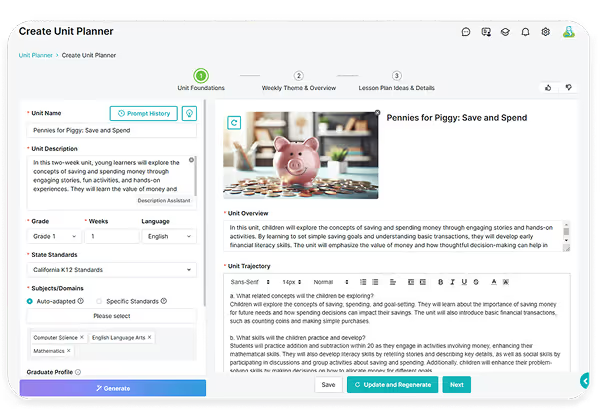
Insight Genie
Effortless Insights: Automatically analyze your attendance, ratings, and progress data, giving you instant insights at your fingertips;
Data-driven Decisions: Unlock AI-powered insights to make smarter decisions, backed by real-time data that drives results.
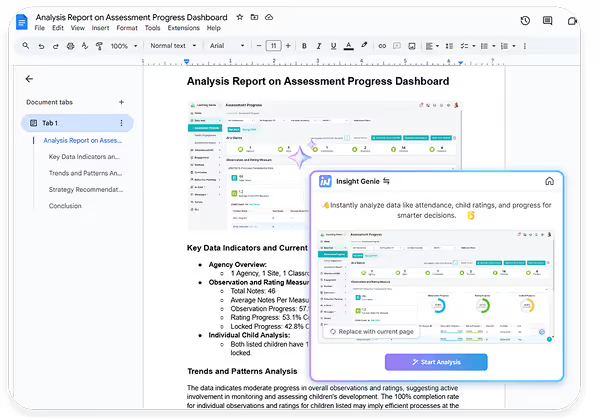
Lesson Plan
Easily transform brief lesson plan ideas into detailed, standards-aligned plans tailored to the special needs of children in your classroom. Instantly generate plans from uploaded PDFs, Word documents, or URLs.
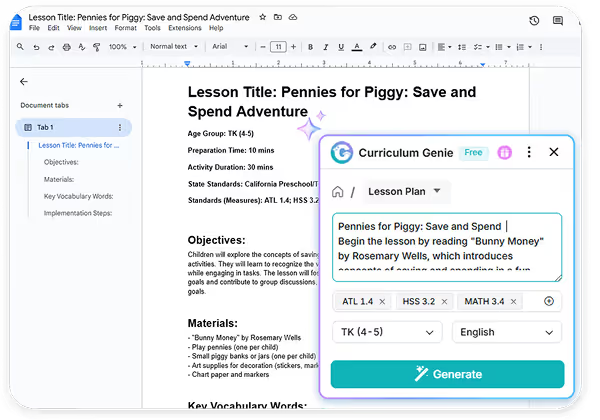
Bloom-Integrated Quiz
Create Quizzes with Bloom's Taxonomy: Craft Bloom's Taxonomy-based quizzes at diverse cognitive levels in Google Forms and Docs seamlessly.
Customizable Assessments: Customize assessments according to specific learning objectives, complete with integrated answer keys, ensuring a comprehensive and goal-oriented evaluation of student comprehension.

Decodable Text
Decodable Text for Phonics Practice: Easily create phonics practice texts based on your specifications, helping children improve their reading skills.
Boost Early Literacy: Craft engaging texts that empower children to master 10 key phonics skills, making reading fun and effective.

Teaching Resource
Quickly create diverse educational materials or resources to boost student engagement and enhance classroom instruction.
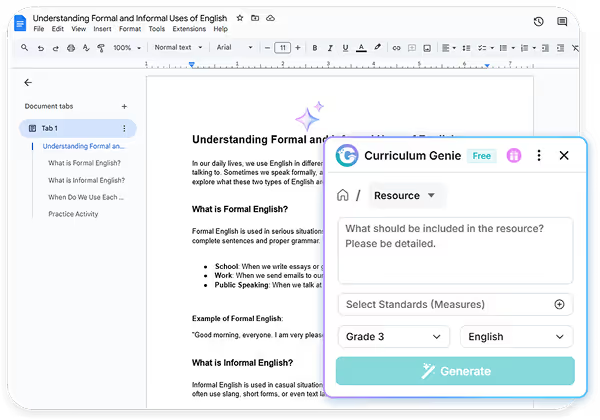
Inquiry-Based Worksheet
Quickly design personalized K-12 worksheets with engaging activities that foster critical thinking and deepen students' understanding across all grade levels.
Align worksheets with your lesson plans and include built-in answer keys for easy assessment.

Exemplar
Generate high-quality examples that showcase different levels of understanding, helping you set clear benchmarks and guide student progress.

Translation
Instantly translate any online content or your own text into another language with ease and accuracy.

Lesson Adapter
Tailor lessons by age group, learning standards, and geographical location, ensuring relevant and impactful learning.
Craft "UDL, Cultural Responsive, quizzes and worksheets" based on the lesson plan, enhancing student engagement and learning outcomes.
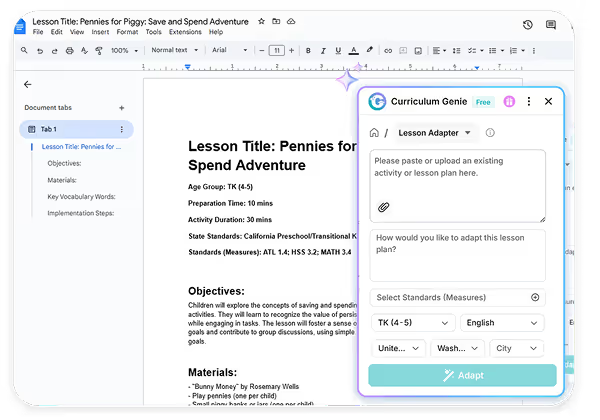
Personalized Lesson
Customize your teaching to fit each student's cultural background, language, and special needs, fostering a truly inclusive learning environment.
Adapt lessons based on students' country, race, home language, and IEP/ELD needs for personalized instruction.

Integration with EduProtocols
Intelligently recommend the best aligned template for each lesson plan.
Instantly create engaging, student-ready activities designed to maximize interaction and learning outcomes.
Seamlessly export to Google Drive, Google Classroom, or download with just one click for effortless sharing.

Why Educators Trust Curriculm Genie
At Curriculum Genie, teachers, families, and students are at the heart of everything we do. Get a glimpse of the smiles we see every day!
Curriculum Genie
Your all-in-one AI teaching tool, enhancing your teaching effectiveness.

Explore the Future of Work with Learning Genie's AI
Smart, efficient, and secure lesson planning platform to boost your team’s productivity.
Frequently Asked Questions
Curriculum Genie is an AI Curriculum Agent designed to help educators quickly develop a comprehensive and well-structured teaching unit in 8 minutes. It leverages advanced AI technologies, such as GPT-4 and GPT-O1, to streamline curriculum development, saving educators time and enhancing instructional quality. Trusted by over 300 Local Education Agencies (LEAs) and 20,000 educators worldwide, Curriculum Genie has been recognized as one of the Tech & Learning Awards of Excellence: Best of 2024 winners by Tech & Learning Magazine. The platform is part of the Learning Genie ecosystem, which focuses on early childhood and K-12 education, offering smart teaching tools for efficient learning, family engagement, and portfolio-based assessment.
Yes! Curriculum Genie is free to use. No subscription is required to start using Curriculum Genie.
Once you sign up, you'll get access to two key features:
- Unit Planner: Create complete unit plans in just 8 minutes — fast, structured, and aligned.
- Individual Educator Free: Start with 4 free unit credits.
- Earn More for Sharing: Get 2 additional free units each time you share the unit on social media (forever free).
- Export Easily: Download all your plans and resources directly to Google Docs and Google Slides, with no limits.
- Lesson Plan: Create unlimited, standards-aligned, and localized lesson plans. You can also customize and adapt any lesson to fit your own teaching needs.
Curriculum Genie is designed to empower educators across a wide range of subjects and grade levels (from PreK-Grade 12). With its powerful AI-driven platform, Curriculum Genie makes it easy to create, customize, and align curriculum materials for diverse educational needs. Here's an overview of the subject areas and standards supported:
- Core Academic Subjects
- Mathematics:
The platform helps teachers build math lessons that are developmentally appropriate, standards-aligned, and engaging—from foundational numeracy in early childhood to advanced problem-solving. - Science:
Curriculum Genie can create and customize science units across life, earth, and physical sciences, integrating inquiry-based approaches and hands-on activities. - Social Studies:
Teachers can plan lessons on history, geography, civics, and more, with built-in alignment to state social studies frameworks. - Language Arts & Literacy:
Curriculum Genie supports curriculum planning for reading, writing, speaking, and listening. It can generate lessons and units aligned with state ELA standards and promote early literacy development.
- Mathematics:
- Early Childhood Education
- DRDP & Early Learning Standards:
Curriculum Genie is especially robust for early childhood education, supporting lesson and curriculum design based on the Desired Results Developmental Profile (DRDP) and other state-specific early learning guidelines. It covers all key learning domains—including approaches to learning, social-emotional development, language, literacy, mathematics, and physical development.
- DRDP & Early Learning Standards:
- Cross-Disciplinary and Interdisciplinary Support: Curriculum Genie is designed to make cross-curricular teaching easy and effective. The platform empowers educators to integrate multiple subject areas into cohesive learning experiences, supporting project-based and interdisciplinary approaches.
- STEM & STEAM Integration:
Curriculum Genie helps educators blend science, technology, engineering, mathematics, and the arts into unified, engaging projects and lessons. - Thematic Units:
Teachers can design units that connect literacy, math, science, social studies, and more around central themes or real-world problems, promoting deeper understanding and student engagement. - Flexible Customization:
Educators can easily tailor and adapt lessons to fit their school’s unique curriculum goals, local priorities, or student interests, ensuring that learning is meaningful and relevant.
- STEM & STEAM Integration:
- Standards and Customization
- All 50 States' Standards:
Curriculum Genie supports alignment with all U.S. state standards and frameworks, ensuring lessons and units meet required benchmarks, whether for core subjects or specialized programs. - Custom Subjects & Themes:
Educators can create custom units around unique themes, local priorities, or interdisciplinary projects. The AI can suggest lesson content for virtually any topic or subject area you need.
- All 50 States' Standards:
Curriculum Genie offers flexible, comprehensive support for nearly any subject taught in early childhood, elementary, and beyond. Whether you’re planning for core academics or cross-curricular subjects, the platform helps ensure your curriculum is standards-aligned, developmentally appropriate, and engaging for every learner.
Curriculum Genie is an agentic AI tool designed to help educators efficiently generate high-quality unit plans, lesson plans, and other instructional materials. To ensure ethical, effective, and responsible use of Curriculum Genie, please follow these best practices:
- Collaborate with AI, Finalize with Your Expertise
Curriculum Genie helps you quickly generate structured, standards-aligned curriculum. Use it as a creative partner to jumpstart your planning process, then bring in your professional expertise to review, adapt, and personalize the materials for your students, context, and teaching style. - Check for Accuracy and Bias
While Curriculum Genie includes internal quality control measures to help ensure the reliability of generated content, it's still important to review everything for accuracy, bias, and contextual fit. Even well-crafted outputs benefit from your professional insight. - Stay Within Your School's Guidelines
Adhere to your district's policies for curriculum development and technology use. Use Curriculum Genie to enhance your instructional planning, not replace approved curricular resources.
By following these best practices, you can use Curriculum Genie responsibly to save time, spark creativity, and support high-quality teaching.
When you sign up for your Curriculum Genie account, you automatically receive free permission to create 4 units. Each successful referral grants you access to create 2 additional units. If you haven’t received your reward yet, it may be due to one of the following reasons:
- Reward processing delay
Our system processes referral rewards with a short delay. Typically, rewards are credited within 2 minutes after the referral. - You’ve reached the maximum limit
You've already earned the maximum referral rewards — 12 extra units from 6 referrals. Once you hit this limit, no further rewards will be added.
Where can I check my rewards?
Click your profile avatar to view your reward history and track your earned units.

How can I get more rewards?
Download our Chrome Extension and receive 2 additional units as a bonus.
